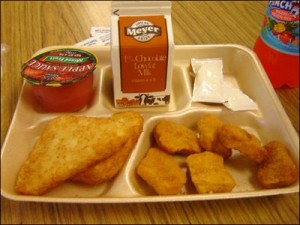Whether it is school lunch programs considering pizza to be a vegetable or meat made of “pink slime,” school lunches may not be the best alternative for children’s health. Government subsidized school lunches are great for low income families. It is also an easy alternative for a lot of time-strapped parents, who may still have to pay. But, are school lunches the healthier alternative?
With the passage of the National School Lunch Act in 1946, the National School Lunch Program (NSLP) was created. Originally it was looked upon as a foundation for children’s health in the U.S. It was also a way to utilize local farmers’ surplus crops.
According to the School Nutrition Association, the NSLP was established as a “measure of national security, to safeguard the health and well-being of the nation’s children and to encourage domestic consumption of nutritious agricultural commodities.” But, a lot has changed since it was first established.
Food Security for Underprivileged Youth
The NSLP provides free or reduced cost meals for 31 million children who qualify in 101,000 public schools in the United States. In addition, there is the School Breakfast Program, which was introduced in 1966 as a pilot and became permanent in 1975. Together, they guarantee those students in low-income families will get at least two full meals on school days.
This is important because food insecurity is a major problem in the United States. Children need enough quality food for proper growth and development. Children’s food security can also affect a child’s success with regards to family life, overall health, and educational outcomes. For those who are living in poverty, food insecurity is a huge risk to children’s cognitive, growth, behavioral, and health potentials.
Food insecurity has been on the rise as food prices rise and incomes stagnate. More than 21 percent of households with children have food insecurity problems. NSLP helps with these issues by freeing up food at home for other family members, reducing uncertainty about availability of food at home, and giving meals to children who might otherwise not have a meal.
NSLP Nutrition Guidelines
School lunches must meet applicable recommendations of the Dietary Guidelines for Americans (DGA). The DGA recommends that no more than 30 percent of a child’s calories come from fat and no more than ten percent from saturated fat. School lunches are also expected to provide at least one-third of the Recommended Daily Allowance of calcium, Vitamin C, calories, iron, and Vitamin A.
Despite these guidelines, school lunches are not as nutritious as they may seem. School lunches can contribute to malnutrition by providing excessive consumption of unhealthy foods. Unhealthy adult eating patterns have been linked directly to unhealthy habits learned as a child at school. A 2010 study of Michigan junior high student found students who ate school lunches were more likely to be obese.
There are also controversies surrounding sugar content in school lunches. Currently, there are no limits to how much refined sugar can be packed into school lunches. In fact, the majority of school lunches are made up of over-processed foods. Studies have also found that children will just throw away fruits and vegetables. It is clear that education needs to be part of the nutrition guidelines.
Tips for Packing Lunches
The NSLP is a great program for helping children from low income families who may otherwise not get breakfast or lunch. But, for those who do not qualify, a sack lunch may be a better alternative. Lunch money may end up in the unhealthy school vending machines or may go to non-food items. Also, without a price reduction, school lunches are often overpriced.
Packing lunches for children can be done with little planning and only a few resources. It is best to purchase a lunch box (to keep sandwiches and other items from getting squished) and a thermos (to keep hot things hot). It is important that children drink enough milk, so fill a small, reseal-able bottle half way with milk the night before. Put it in the freezer. The next morning, fill the bottle the rest of the way with milk. The frozen milk will melt by lunch time, and the child will have cold milk.
Another tip is to make all the sandwiches for the week on Sunday night and toss them in the freezer. They thaw by the time lunch rolls around. Bananas, apples, and oranges work well in a lunch. It is also important to listen closely to what kids like and do not like in their lunches. They will likely want the school lunch, but it is important to be firm and let them know school lunch is not an option.
(http://environment.about.com/od/healthandchildren/a/cafeteria_food.htm)

